The hybrid DreamCloud and the all-foam Casper are both popular online mattresses, so it can be tough to determine which bed is best for your unique sleep needs. That’s why we’ve pitted the newest DreamCloud model against the original all-foam Casper—so you can get all the information you need to select the best mattress for you.
Ready to gain some clarity? Read on for our comprehensive DreamCloud vs Casper comparison! We’ll compare the DreamCloud Luxury Hybrid mattress to the original Casper by reviewing these beds’ firmness, feel, construction, and performance. We’ll also outline who’s most likely to prefer which mattress. Let’s dive in!
DreamCloud vs Casper
Product
Firmness
Score
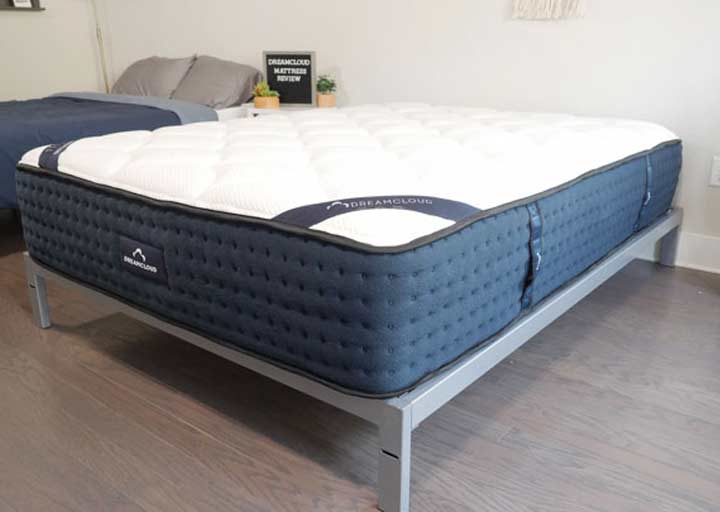
Product
Firmness
Score
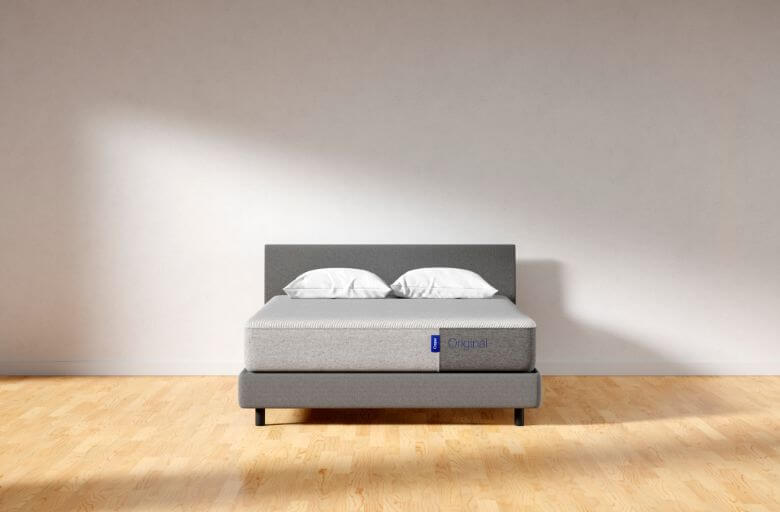
Product
Firmness
Score
DreamCloud Vs Casper Overview
The DreamCloud Luxury Hybrid and the original Casper feature different constructions and feels, which means each bed is better suited to different types of sleepers. Here’s a quick look at who’s most likely to prefer the DreamCloud and who might enjoy the Casper.
| Who Should Choose the DreamCloud? | Who Should Choose the Casper? |
| Hot sleepers who need a mattress that sleeps cool | Combination sleepers who need to feel comfortable in multiple positions |
| Folks who like a firmer mattress | Folks who are looking to save some money |
| Stomach sleepers | People who enjoy a balanced foam feel |
DreamCloud vs Casper: Similarities and Differences
Even though these beds differ in construction and feel, they still have a few things in common. Let’s take a look at their similarities and differences.
| Similarities | Differences |
| Both mattresses offer good support. | There are major construction differences between these two beds: The DreamCloud is a hybrid mattress that incorporates coils, while the Casper is all-foam. |
| Both mattresses feature memory foam in their comfort layer. | The DreamCloud has an innerspring feel, while the Casper features a balanced foam feel. |
| Both companies offer free shipping, generous sleep trials, and great customer service. | The DreamCloud is firmer than the Casper. |
| At full price, the Casper costs less than the DreamCloud. |
Firmness And Feel Differences
When you’re shopping for any mattress, it’s crucial to consider firmness and feel. These factors will tell you a lot about whether a particular bed is suited to your preferred sleep position(s) and other sleep needs. So without further ado, let’s look at the firmness and feel on the DreamCloud and Casper mattresses!
How Firm Are The DreamCloud And Casper Mattresses?
We ranked the DreamCloud around a 7.5 out of 10 on the firmness scale. The industry standard for average firmness is 6.5/10, so this suggests the DreamCloud is notably firm. Meanwhile, we ranked the Casper around a 7/10. This suggests that it’s firmer-than-average but softer than the DreamCloud.
Note that firmness is a bit subjective. Depending on your body weight and personal preferences, you might find these mattresses feel a touch firmer or softer than our assessment.
Sleeping On The DreamCloud And Casper Mattresses
Now, let’s discuss how it actually feels to sleep on both these mattresses:
DreamCloud
We found the DreamCloud to be a pleasant match for back sleeping. It offered nice lumbar support, and our spine stayed aligned.
The DreamCloud is not an ideal match for side sleeping. We experienced a significant amount of pressure in this position and felt jammed up around the shoulder and hip.
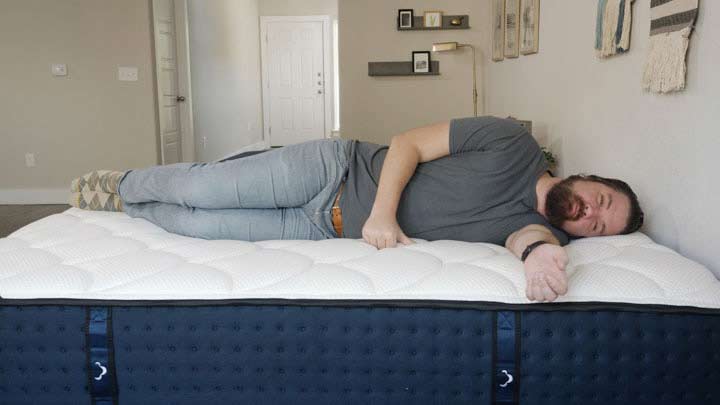
Even though the DreamCloud feels too firm for side sleeping, our heavier-weight reviewer found it to be a bit too soft for stomach sleeping. His hips bowed into the mattress and pulled his spine out of alignment. That said, lightweight and average-weight stomach sleepers should find more support here.
Want to try the DreamCloud for yourself? Learn where to find a DreamCloud mattress near you.
Casper
We enjoyed just enough support while back sleeping on the Casper. Our hips sank in for a touch of pressure relief, but we still felt plenty of lumbar support. This is due to the Zoned Support which makes the mattress firmer under the lumbar area.
We felt okay but not great while side sleeping on the Casper, and we experienced a touch of pressure around the shoulder and hip. Lightweight folks might experience better pressure relief.
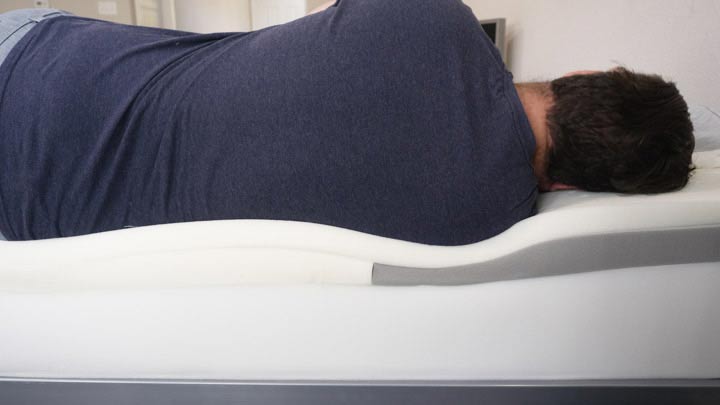
Thanks to the Casper’s Zoned Support, we felt fairly well supported while stomach sleeping on this mattress. However, if you spend all night on your stomach, you might want to look for a firmer mattress for stomach sleepers.
What Do The DreamCloud And Casper Mattresses Feel Like?
Even though the DreamCloud is a hybrid mattress, it mostly has an innerspring feel. It has a layer of memory foam near the top, but it doesn’t have the slow-moving feel that’s often associated with memory foam. Instead, it’s bouncy and responsive, and it’s easy to move around on top of this mattress.
The Casper features a balanced and responsive foam feel. Even though this is an all-foam mattress, it’s surprisingly bouncy. That bounce makes it easy to change positions and move around on top of the bed.
Average Weight Sleepers – 130lbs – 230lbs
Back sleepers who weigh closer to 130 pounds might find that the DreamCloud feels too firm, while folks who weigh closer to 230 pounds should enjoy pleasant support in this position. The DreamCloud is almost certainly too firm for average-weight side sleepers, who are likely to experience pressure around the shoulder and hip. Average-weight stomach sleepers should enjoy decent support in this position.
The Casper could be a great match for average-weight back sleepers, who should enjoy a blend of pressure relief and spinal support. This mattress could offer enough pressure relief to side sleepers, particularly those on the lighter end of the weight spectrum—though side sleepers who prefer a plusher feel will want to look for a dedicated mattress for side sleeping. The Casper could suit some average-weight stomach sleepers, though folks who prefer this position will probably find better support on the DreamCloud.
Heavyweight Sleepers – Over 230lbs
Back sleepers who weigh less than 300 pounds should obtain adequate support on the DreamCloud, while folks who weigh more than that will want to seek out a mattress for heavy people. The DreamCloud might feel too firm for some heavyweight side sleepers, and folks who weigh more than 300 pounds will require a more supportive mattress. A similar theme holds true for stomach sleepers: Folks who weigh less than 300 pounds could obtain adequate support, while those who weigh more than that will require a more supportive mattress overall.
The Casper should provide a pleasant balance of pressure relief and spinal support to back sleepers who weigh less than 300 pounds. Folks who weigh more than that will want to look for a more supportive mattress. The Casper might offer adequate pressure relief to side sleepers who weigh less than 300 pounds, while folks who weigh more than that will almost definitely crave more support. The Casper is probably not supportive enough for heavyweight stomach sleepers.
Lightweight Sleepers – Under 130lbs
Lightweight back sleepers will enjoy plenty of spinal support on the DreamCloud, but the mattress might feel too firm in this position. Lightweight side sleepers who like a firmer feel might enjoy the DreamCloud, but many side sleepers will find this mattress too firm. The DreamCloud is supportive enough for lightweight stomach sleepers.
The Casper is well suited to lightweight back sleepers, who should enjoy a balance of comfort and support on this bed. Lightweight side sleepers could obtain adequate pressure relief on this mattress, although folks who enjoy an extra-plush feel will want to look elsewhere. The Casper should provide adequate spinal support for lightweight stomach sleepers.
Mattress Construction Differences
Now that you have a sense of what it’s like to lie on top of the DreamCloud and Casper mattresses, let’s peel back their covers and take a look at what’s inside of these beds! We’ll assess their constructions layer by layer and share how different materials influence performance.
DreamCloud
| Layer | Description |
| Cover | The DreamCloud boasts a cashmere cover on top. This material is very soft and breathable, and it’s quilted with foam for a touch of additional pressure relief. |
| Comfort Layer #1 | Below its quilted cover, the DreamCloud features a comfort layer made of gel memory foam. This layer is soft and pressure-relieving, and it’s infused with gel to help with cooling. |
| Comfort Layer # 2 | Underneath this primary comfort layer, there’s a transition layer made of firmer foam. This helps prevent sleepers from sinking too deeply into the mattress and hitting the firm support coils underneath. |
| Support Layer | True to its hybrid form, the DreamCloud features a support layer made from individually-wrapped coils. These coils lend bounciness and support to the mattress overall. |
Casper
| Layer | Description |
| Cover | The Casper features a breathable cover that’s partially made from recycled bottles. |
| Comfort Layer #1 | The Casper’s top comfort layer is made from the brand’s proprietary AirScape foam — a breathable foam that’s perforated to allow for extra airflow. This material is plush but also responsive. |
| Comfort Layer # 2 | Underneath the Airscape foam, you’ll find the main feature of the Casper: Zoned Support. This is a layer of memory foam that’s firmer near the center and softer near the head and foot. The idea is to make the mattress feel firmer and more supportive for back and stomach sleeping while making it softer and more pressure relieving for side sleeping. |
| Support Layer | The all-foam Casper features a support layer made from a high-density base polyfoam that creates structure and support for the entire mattress. |
Mattress Height
The DreamCloud stands at 14” tall, while the Casper is shorter at 11” tall.
DreamCloud And Casper Mattress Size Options And Price
To see the most up-to-date size and pricing information for the DreamCloud and Casper mattresses, check out the charts below!
DreamCloud
| Size | Dimensions | Price |
| Twin | 38″ x 75″ | $1014.00 |
| Twin XL | 38″ x 80″ | $1098.00 |
| Full | 54″ x 75″ | $1364.00 |
| Queen | 60″ x 80″ | $1531.00 |
| King | 76″ x 80″ | $1898.00 |
| California King | 72″ x 84″ | $1898.00 |
Casper
| Size | Dimensions | Price |
| Twin | 39″ x 75″ | $895.00 |
| Twin XL | 39″ x 80″ | $995.00 |
| Full | 53″ x 75″ | $1195.00 |
| Queen | 60″ x 80″ | $1295.00 |
| King | 76″ x 80″ | $1695.00 |
| California King | 72″ x 84″ | $1695.00 |
Product
Firmness
Score

Product
Firmness
Score

Product
Firmness
Score
DreamCloud And Casper Performance Differences
Firmness, feel, and construction tell you a lot about a mattress, but they’re not the whole story. To really get to know a bed, it’s also important to consider key performance factors. We’ve pitted the DreamCloud and Casper head-to-head with respect to temperature regulation, motion transfer, edge support, and more. Let’s see how they stack up!
Also, make sure to check out our mattress comparisons page for other DreamCloud and Casper comparisons like DreamCloud vs WinkBed and Casper vs Purple.
Sleeping Hot Or Cold
The DreamCloud takes the win here. The coils in its support layer allow for plenty of airflow through the mattress, while the all-foam Casper could trap some heat.
Motion Transfer
The Casper should win out thanks to the thick memory foam comfort layer, which does a great job of absorbing motion and minimizing movement across the surface of the bed. This could make it a great mattress for couples. Because the DreamCloud is a bouncy mattress that incorporates coils, it doesn’t minimize motion transfer as well.
Edge Support
Both the DreamCloud and the Casper boast decent edge support. The DreamCloud might be a touch more supportive thanks to its strong coils.
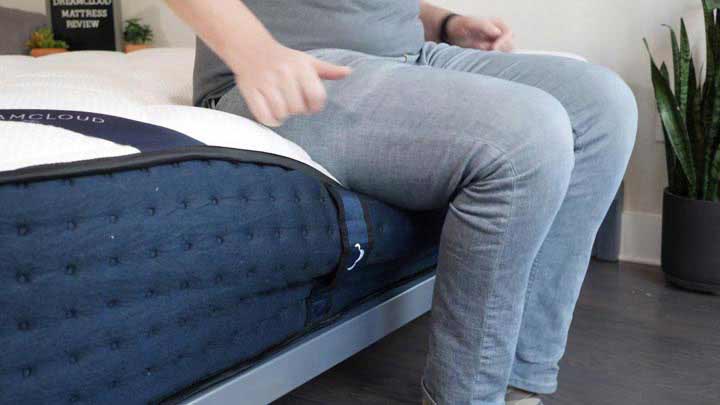
Durability
We’re calling this a draw. Both the DreamCloud and the Casper are made from durable materials, and both mattresses should last for between 7 and 10 years (assuming proper care).
Off-Gassing
We observed some initial off-gassing from both the DreamCloud and the Casper. This should dissipate after 48 hours.
Noise
We didn’t observe any notable noise from either mattress. That said, because the DreamCloud incorporates coils in its construction, it’s possible that they could start to squeak a bit over time.
Sex
When people seek out a mattress for sex, they’re usually concerned about being able to change positions easily. The DreamCloud should win out here because it’s bouncier and more responsive than the Casper. Partners shouldn’t feel stuck in this mattress, and it should be easy to move around on top of the bed.
Company Policies
Here’s a quick look at the company policies for the DreamCloud and Casper brands.
Warranty Info
The DreamCloud mattress comes with a Forever Warranty, and the Casper mattress comes with a 10-year warranty. Both of these warranties cover defects but are void if you don’t use the correct frame or support system.
Sleep Trial
The DreamCloud boasts a 365-night sleep trial, which is longer-than-average. The Casper comes with a 100-night sleep trial.
Return Policy
Both companies offer free returns. If during the sleep trial, the mattress isn’t the best fit, you can return it for a full refund.

